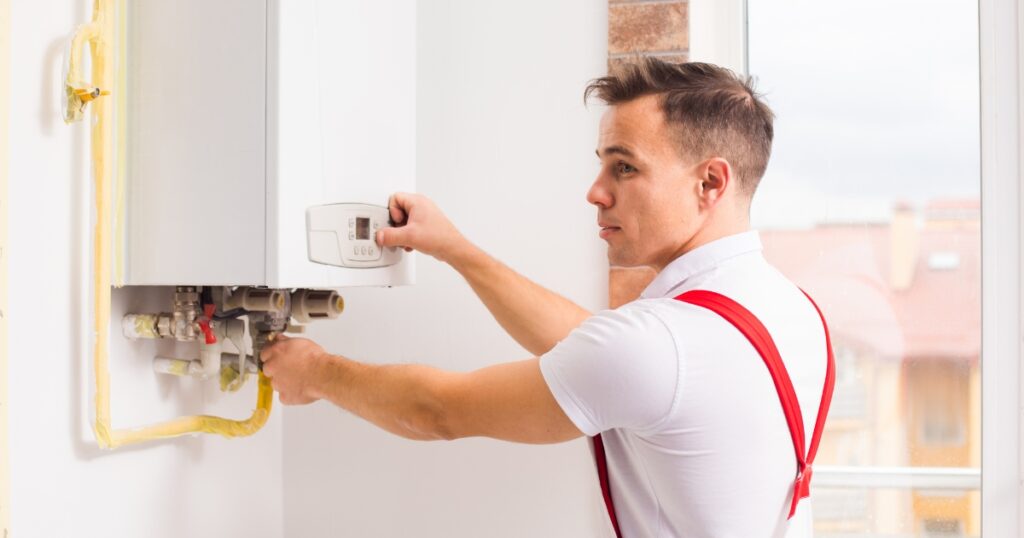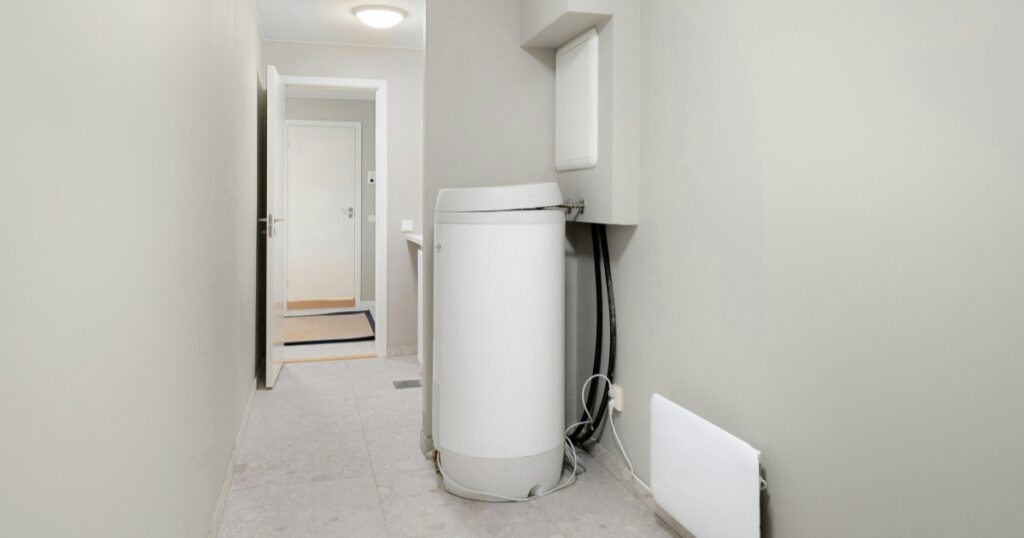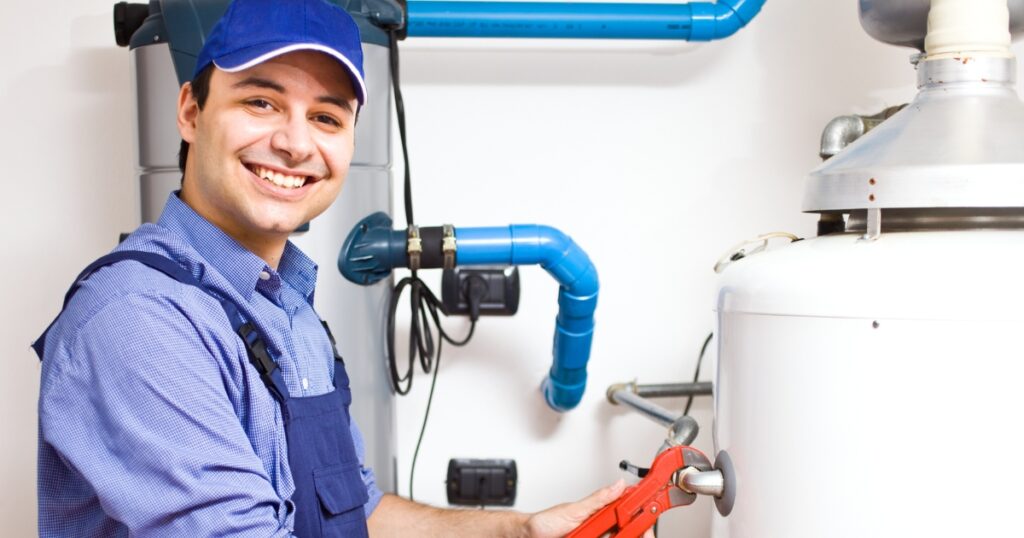Setting the perfect temp on your hot water system can be a bit like finding a needle in a haystack, hey? No worries though – we’ve all had our fair share of battles with that pesky dial.
But fear not, because our guide’s gonna help you nail down that ideal setting for safety and cosiness without sending your bills through the roof. So grab a cuppa and settle in as we spill the beans on mastering your thermostat.
Ready to crank up some savvy tips? Let’s get into it!
Key Takeaways
- Setting the optimal temperature on your hot water heater enhances safety by reducing the risk of scalding, while also promoting energy efficiency.
- Maintaining recommended temperature settings not only ensures better hygiene but also provides a more comfortable bathing experience for you and your family.
- Consulting a professional plumber for precise adjustments or upgrading to programmable thermostats can help you achieve cost-effective and efficient hot water usage.
Why Optimal Hot Water Heater Settings Are Important
Optimal hot water heater settings are important for several reasons. They not only enhance safety, efficiency, and hygiene but also improve comfort and extend the lifespan of the water heater.

Improved safety
Setting your hot water heater thermostat to the ideal temperature doesn’t just save on energy bills; it also keeps us safer. Scalding is a real risk, especially for young children and the elderly with more sensitive skin.
By finding that sweet spot in temperature settings, we reduce the chances of burns from taps around the house.
With proper adjustments, our water heaters work within safe parameters. This means less worry about unexpected spikes in heat or dangerously high temperatures that could lead to accidents.
And speaking of efficiency, let’s explore how an optimal setting can make our system not only safer but also more cost-effective.
Enhanced efficiency
To further improve the efficiency of your hot water system, consider upgrading to a programmable or smart thermostat. These modern thermostats offer advanced features that allow you to schedule temperature adjustments based on your household’s hot water usage patterns.
By optimising your water heater settings and avoiding unnecessary heating during periods of low demand, you can reduce energy consumption and save on utility costs. Additionally, insulating your hot water pipes helps maintain the heat of the water as it travels from the heater to its point of use, minimising heat loss and maximising overall system efficiency.
By taking advantage of solar water heating technology, you can harness renewable energy sources to supplement your hot water supply. This sustainable approach not only reduces dependence on traditional power sources but also contributes to long-term cost savings while minimising environmental impact.
Better hygiene
To further enhance the efficiency of your hot water system, maintaining optimal temperature settings is crucial for promoting better hygiene. By setting the water heater to an appropriate temperature, you can ensure that your household has access to hot water that effectively kills bacteria and other harmful microorganisms.
This not only provides cleaner and safer bathing and handwashing experiences but also reduces the risk of infections and illnesses due to inadequate hot water temperatures. Regularly checking and adjusting the thermostat settings will contribute significantly to maintaining a hygienic environment in your home.
By implementing these practices, you can maintain ideal hot water temperatures for improved hygiene which in turn promotes a healthier living environment without compromising on safety or comfort.
Increased comfort
If you’re someone who enjoys a relaxing hot shower or bath, setting the optimal temperature on your hot water heater can significantly enhance your comfort. By ensuring that the water temperature is just right, you can enjoy a more soothing and enjoyable bathing experience.
The ideal temperature provides warmth without scalding, allowing you to fully indulge in the comfort of your daily showers and baths. Adjusting the thermostat settings to achieve this perfect balance will make every moment in the bathroom more pleasant and rejuvenating.
To further enhance your comfort when using hot water at home, consider setting the optimal temperature for your hot water heater.
Longer lifespan of the water heater
To ensure a longer lifespan for your water heater, it’s important to maintain the optimal temperature settings. Consistently running your water heater at higher temperatures can lead to accelerated wear and tear on the internal components, potentially shortening its operational life.
By setting the temperature within the recommended range and ensuring that it is not excessively high, you can help prolong the lifespan of your water heater system, reducing the frequency of repairs and replacements while saving money in the long run.
Regularly checking and adjusting your hot water heater thermostat can also contribute to extending its longevity. This simple maintenance task helps prevent overheating or excessive strain on the system, promoting efficient operation and durability over time.
The Dangers of High Hot Water Temperatures
Hot water temperatures set too high can pose serious risks, including scalding and burns. Elevated temperatures in the hot water tank increase the likelihood of accidental burns during everyday activities like bathing, washing dishes or clothes.
High temperatures also encourage bacterial growth, which can compromise hygiene and health. When not properly controlled, extremely hot water can damage skin and lead to severe injuries.
To prevent these dangers, it’s crucial to ensure that your hot water heater is set at a safe and optimal temperature.
Excessively high hot water temperatures waste energy as well as money because they force the system to work harder than necessary. This increased strain on the system could potentially reduce its lifespan while also increasing utility bills unnecessarily.
Moreover, very high temperatures can cause corrosion in pipes and other components of the heating system over time. Therefore, maintaining an appropriate hot water temperature not only ensures safety but also promotes efficiency and cost savings.

How to Adjust and Maintain the Water Heater Temperature
To adjust and maintain the water heater temperature, it’s important to consider seeking assistance from a professional plumber for precise adjustments. Additionally, you can opt for programmable or smart thermostats for more control over the temperature settings.
Insulating your hot water pipes can also help in maintaining the desired temperature levels. Regularly checking the thermostat settings will ensure that your hot water heater is functioning efficiently.
Contact a professional plumber
For best results, engaging a professional plumber is essential. They have the expertise and experience to ensure that your hot water heater is set to the optimal temperature according to safety standards.
A licensed plumber can also inspect and maintain your water heater regularly, ensuring it continues to function efficiently and safely for years to come.
Not only will a professional plumber adjust the thermostat settings correctly, but they can also provide valuable advice on energy-efficient options and any potential upgrades that could save you money in the long run.
Consider using a programmable or smart thermostat
After consulting a professional plumber and making necessary adjustments to your water heater temperature, consider using a programmable or smart thermostat. These devices offer the convenience of setting specific temperatures for different times of the day or night, reducing energy consumption drastically.
By programming your hot water usage patterns, you can ensure that your water heater is only working when needed most, leading to significant cost savings over time. Additionally, smart thermostats provide the flexibility to monitor and control your hot water system remotely through a smartphone app, giving you peace of mind even when away from home.
Smart thermostats also come with advanced features such as learning algorithms that analyse your usage patterns and adjust settings accordingly for maximum efficiency. This ensures that you have consistent access to hot water while minimising energy wastage.
Take advantage of solar water heating
Consider using a programmable or smart thermostat to regulate the water heater temperature efficiently. In addition, take advantage of solar water heating to further reduce your energy consumption and save on utility bills.
Solar water heating systems use sunlight to heat water, providing an environmentally friendly and cost-effective alternative for your hot water needs. Installing solar panels for heating your water can significantly lower your carbon footprint while ensuring reliable access to hot water throughout the year.
Make sure you consult with a professional plumber about integrating solar water heating into your existing system. They can provide expert advice on the installation process and help you understand how this renewable energy source can benefit your household in the long run.
Insulate your hot water pipes
Insulating your hot water pipes is a cost-effective way to maintain the heat of your hot water and prevent energy wastage. It involves wrapping insulation around the pipes connected to your hot water heater, reducing heat loss as the water travels from the heater to your faucets.
This simple step can significantly lower your energy bills and ensure that you have hot water available whenever you need it.
Moreover, insulating your hot water pipes helps maintain a consistent temperature within the pipes, which reduces the waiting time for hot water at faucets or showers. This means less waste while waiting for warm water to reach its destination.
By insulating these pipes, homeowners can enjoy greater energy efficiency and save money on their monthly utility bills. Plus, it contributes to a more environmentally friendly household by conserving valuable resources.
Regularly check the thermostat settings
After insulating your hot water pipes to conserve heat and energy, it’s essential to regularly check the thermostat settings to ensure that your water heater is operating at the optimal temperature.
By doing so, you can maintain an efficient and safe hot water system for your home. Checking the thermostat settings allows you to make any necessary adjustments if there are changes in weather or household water usage, ensuring that you’re not overheating or underheating your water supply.
Monitoring the thermostat settings is straightforward and can be done by simply accessing the control panel on your water heater and making adjustments as needed. This proactive approach helps prevent any potential issues arising from incorrect temperature settings while also ensuring that you have a consistent supply of hot water tailored to meet your household’s needs.
Recommended Temperature Settings
The ideal range for domestic hot water is between 45°C and 55°C, with a maximum temperature of 60°C to prevent scalding. It’s important to set the top heating element slightly higher than the bottom one to ensure an even distribution of hot water throughout the tank.
The ideal range for domestic hot water
Set your hot water heater to a temperature between 120 and 140 degrees Fahrenheit for optimal comfort and efficiency. Always consider the needs of your household, as higher temperatures can pose scalding risks, especially for children and the elderly.
By keeping the temperature within this range, you can ensure that you have enough hot water while also preventing energy wastage.
Maintaining your hot water heater in an ideal setting not only provides consistent warmth but also saves on energy costs. Adjusting the thermostat to suit your usage helps prevent overheating and reduce energy consumption without compromising on comfort or hygiene.
Maximum temperature for a hot water heater
To ensure safe and efficient operation, the maximum temperature for a hot water heater should be set at 120 degrees Fahrenheit (49 degrees Celsius). This temperature strikes a balance between preventing scalding while still being hot enough to meet household needs.
It is essential to note that setting the thermostat too high can result in an increased risk of burns, especially for children and older adults.
Maintaining the maximum temperature within this range not only prevents accidents but also helps conserve energy and reduce utility costs. It’s important to regularly check and adjust the thermostat to ensure that it stays within this safe range – ultimately promoting comfort, safety, and efficiency in your home.
Hot water heater settings for top and bottom heating
Now let’s delve into the optimal hot water heater settings for top and bottom heating. Adjusting the temperature of each element ensures that there is a balanced distribution of heat within the tank, leading to a consistent hot water supply throughout your home.
By setting the top heating element 10-20 degrees higher than the bottom one, you can efficiently maintain a sufficient amount of hot water at all times. This method helps to prevent cold patches in your water, ensuring that it flows consistently when you need it most.
Regularly checking and adjusting these settings will result in an even temperature distribution, contributing to improved efficiency and comfort while also extending the lifespan of your water heater.
Know How to Set the Optimal temperature
In conclusion, setting the optimal temperature for your hot water heater is crucial for safety, efficiency, and comfort. Adjusting the thermostat can improve energy savings and extend the lifespan of your water heater.
By understanding the recommended temperature settings and taking necessary precautions, you can ensure that your hot water system operates at its best. With these simple adjustments, you can enjoy reliable hot water while saving money on utility bills.
Don’t overlook the importance of maintaining a safe and efficient hot water heater – it’s an investment that benefits your home in many ways.






